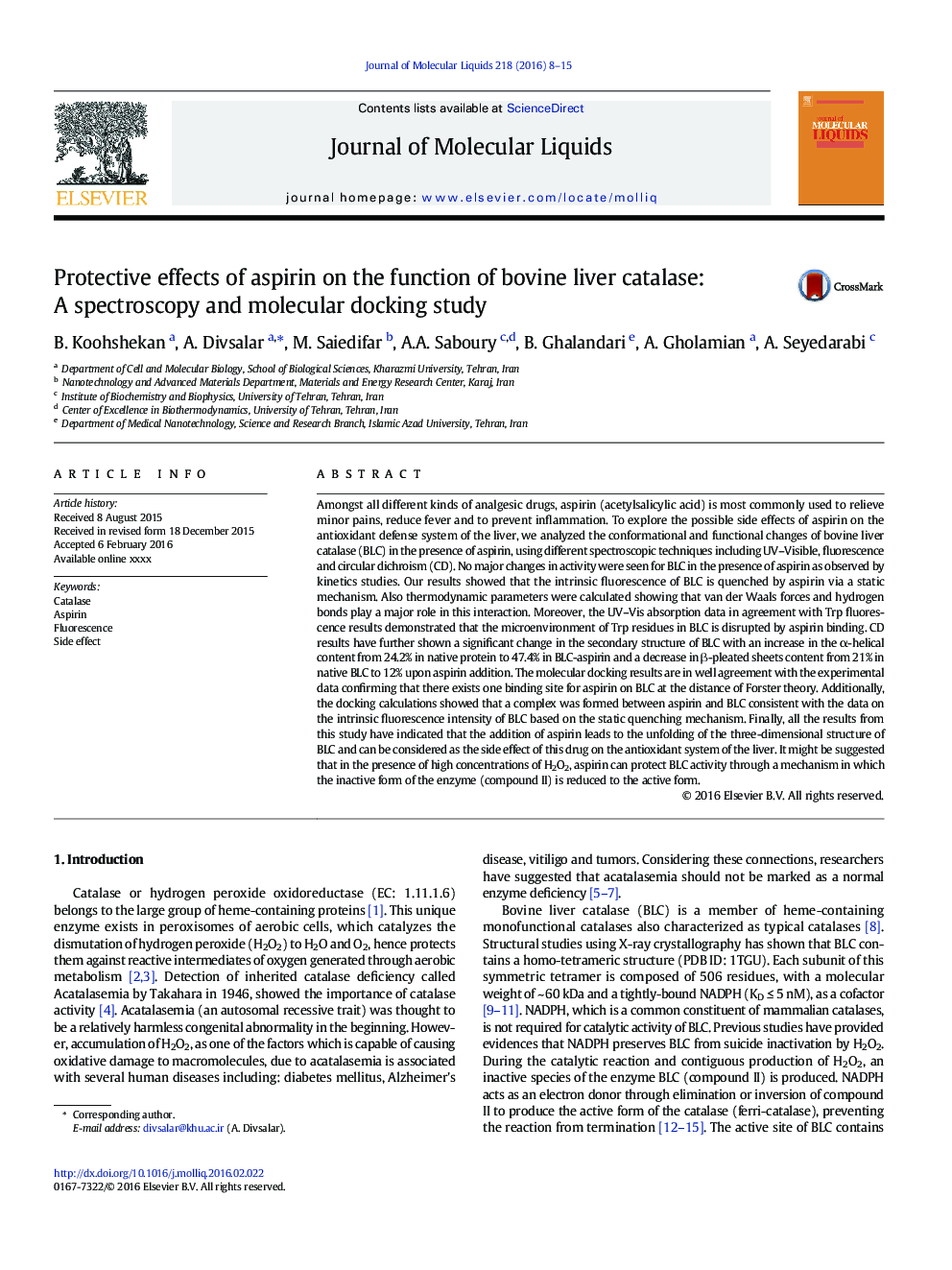| کد مقاله | کد نشریه | سال انتشار | مقاله انگلیسی | نسخه تمام متن |
|---|---|---|---|---|
| 5410364 | 1506552 | 2016 | 8 صفحه PDF | دانلود رایگان |
عنوان انگلیسی مقاله ISI
Protective effects of aspirin on the function of bovine liver catalase: A spectroscopy and molecular docking study
ترجمه فارسی عنوان
اثرات محافظتی آسپیرین بر عملکرد کاتالاز کبدی گاو: یک مطالعه اسپکتروسکوپی و تکمیل مولکولی
دانلود مقاله + سفارش ترجمه
دانلود مقاله ISI انگلیسی
رایگان برای ایرانیان
کلمات کلیدی
کاتالاز، آسپرین فلورسانس، عوارض جانبی،
موضوعات مرتبط
مهندسی و علوم پایه
شیمی
شیمی تئوریک و عملی
چکیده انگلیسی
Amongst all different kinds of analgesic drugs, aspirin (acetylsalicylic acid) is most commonly used to relieve minor pains, reduce fever and to prevent inflammation. To explore the possible side effects of aspirin on the antioxidant defense system of the liver, we analyzed the conformational and functional changes of bovine liver catalase (BLC) in the presence of aspirin, using different spectroscopic techniques including UV-Visible, fluorescence and circular dichroism (CD). No major changes in activity were seen for BLC in the presence of aspirin as observed by kinetics studies. Our results showed that the intrinsic fluorescence of BLC is quenched by aspirin via a static mechanism. Also thermodynamic parameters were calculated showing that van der Waals forces and hydrogen bonds play a major role in this interaction. Moreover, the UV-Vis absorption data in agreement with Trp fluorescence results demonstrated that the microenvironment of Trp residues in BLC is disrupted by aspirin binding. CD results have further shown a significant change in the secondary structure of BLC with an increase in the α-helical content from 24.2% in native protein to 47.4% in BLC-aspirin and a decrease in β-pleated sheets content from 21% in native BLC to 12% upon aspirin addition. The molecular docking results are in well agreement with the experimental data confirming that there exists one binding site for aspirin on BLC at the distance of Forster theory. Additionally, the docking calculations showed that a complex was formed between aspirin and BLC consistent with the data on the intrinsic fluorescence intensity of BLC based on the static quenching mechanism. Finally, all the results from this study have indicated that the addition of aspirin leads to the unfolding of the three-dimensional structure of BLC and can be considered as the side effect of this drug on the antioxidant system of the liver. It might be suggested that in the presence of high concentrations of H2O2, aspirin can protect BLC activity through a mechanism in which the inactive form of the enzyme (compound II) is reduced to the active form.
ناشر
Database: Elsevier - ScienceDirect (ساینس دایرکت)
Journal: Journal of Molecular Liquids - Volume 218, June 2016, Pages 8-15
Journal: Journal of Molecular Liquids - Volume 218, June 2016, Pages 8-15
نویسندگان
B. Koohshekan, A. Divsalar, M. Saiedifar, A.A. Saboury, B. Ghalandari, A. Gholamian, A. Seyedarabi,
